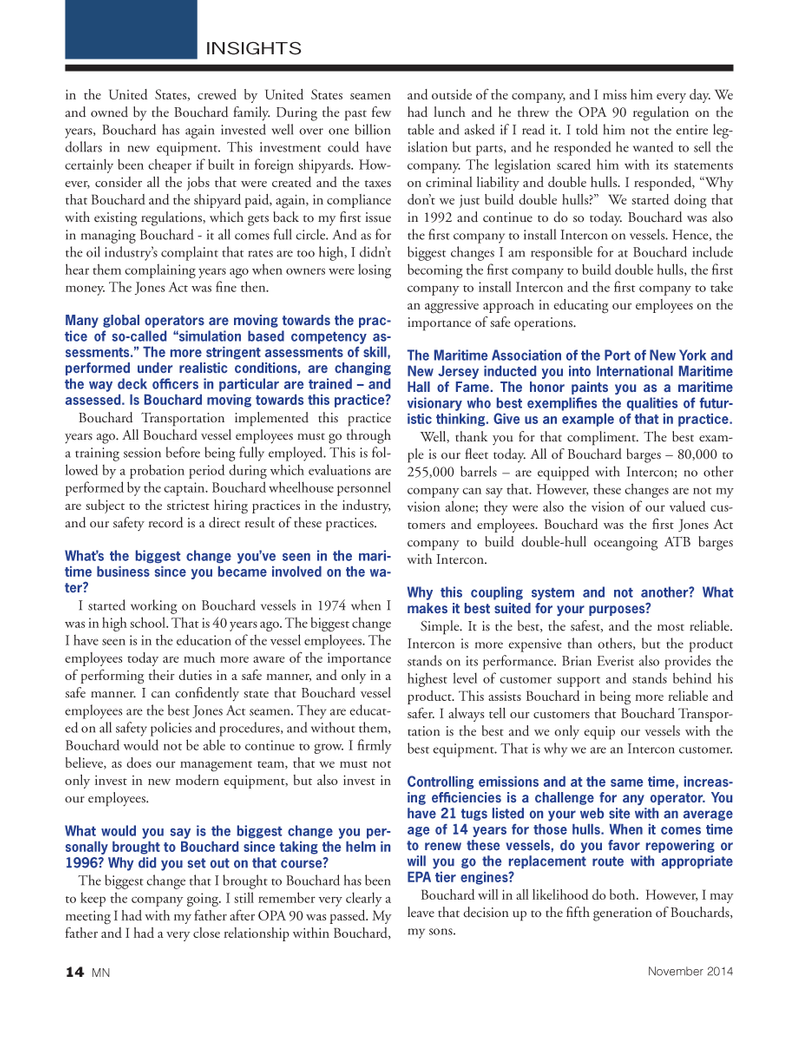
Page 14: of Marine News Magazine (November 2014)
Workboat Annual
Read this page in Pdf, Flash or Html5 edition of November 2014 Marine News Magazine
INSIGHTS in the United States, crewed by United States seamen and owned by the Bouchard family. During the past few years, Bouchard has again invested well over one billion dollars in new equipment. This investment could have certainly been cheaper if built in foreign shipyards. How- ever, consider all the jobs that were created and the taxes that Bouchard and the shipyard paid, again, in compliance with existing regulations, which gets back to my fi rst issue in managing Bouchard - it all comes full circle. And as for the oil industry’s complaint that rates are too high, I didn’t hear them complaining years ago when owners were losing money. The Jones Act was fi ne then.
Many global operators are moving towards the prac- tice of so-called “simulation based competency as- sessments.” The more stringent assessments of skill, performed under realistic conditions, are changing the way deck offi cers in particular are trained – and assessed. Is Bouchard moving towards this practice?
Bouchard Transportation implemented this practice years ago. All Bouchard vessel employees must go through a training session before being fully employed. This is fol- lowed by a probation period during which evaluations are performed by the captain. Bouchard wheelhouse personnel are subject to the strictest hiring practices in the industry, and our safety record is a direct result of these practices.
What’s the biggest change you’ve seen in the mari- time business since you became involved on the wa- ter?
I started working on Bouchard vessels in 1974 when I was in high school. That is 40 years ago. The biggest change
I have seen is in the education of the vessel employees. The employees today are much more aware of the importance of performing their duties in a safe manner, and only in a safe manner. I can confi dently state that Bouchard vessel employees are the best Jones Act seamen. They are educat- ed on all safety policies and procedures, and without them,
Bouchard would not be able to continue to grow. I fi rmly believe, as does our management team, that we must not only invest in new modern equipment, but also invest in our employees.
What would you say is the biggest change you per- sonally brought to Bouchard since taking the helm in 1996? Why did you set out on that course?
The biggest change that I brought to Bouchard has been to keep the company going. I still remember very clearly a meeting I had with my father after OPA 90 was passed. My father and I had a very close relationship within Bouchard, and outside of the company, and I miss him every day. We had lunch and he threw the OPA 90 regulation on the table and asked if I read it. I told him not the entire leg- islation but parts, and he responded he wanted to sell the company. The legislation scared him with its statements on criminal liability and double hulls. I responded, “Why don’t we just build double hulls?” We started doing that in 1992 and continue to do so today. Bouchard was also the fi rst company to install Intercon on vessels. Hence, the biggest changes I am responsible for at Bouchard include becoming the fi rst company to build double hulls, the fi rst company to install Intercon and the fi rst company to take an aggressive approach in educating our employees on the importance of safe operations.
The Maritime Association of the Port of New York and
New Jersey inducted you into International Maritime
Hall of Fame. The honor paints you as a maritime visionary who best exemplifi es the qualities of futur- istic thinking. Give us an example of that in practice.
Well, thank you for that compliment. The best exam- ple is our fl eet today. All of Bouchard barges – 80,000 to 255,000 barrels – are equipped with Intercon; no other company can say that. However, these changes are not my vision alone; they were also the vision of our valued cus- tomers and employees. Bouchard was the fi rst Jones Act company to build double-hull oceangoing ATB barges with Intercon.
Why this coupling system and not another? What makes it best suited for your purposes?
Simple. It is the best, the safest, and the most reliable.
Intercon is more expensive than others, but the product stands on its performance. Brian Everist also provides the highest level of customer support and stands behind his product. This assists Bouchard in being more reliable and safer. I always tell our customers that Bouchard Transpor- tation is the best and we only equip our vessels with the best equipment. That is why we are an Intercon customer.
Controlling emissions and at the same time, increas- ing effi ciencies is a challenge for any operator. You have 21 tugs listed on your web site with an average age of 14 years for those hulls. When it comes time to renew these vessels, do you favor repowering or will you go the replacement route with appropriate
EPA tier engines?
Bouchard will in all likelihood do both. However, I may leave that decision up to the fi fth generation of Bouchards, my sons. 14 MN
November 2014
MN Nov14 Layout 1-17.indd 14 10/20/2014 2:44:18 PM

 13
13

 15
15
